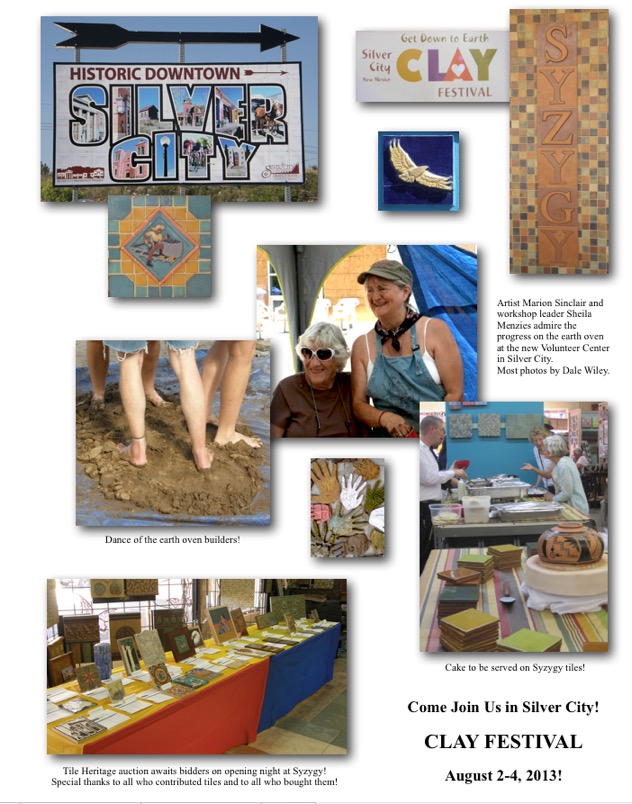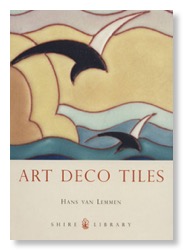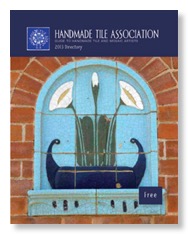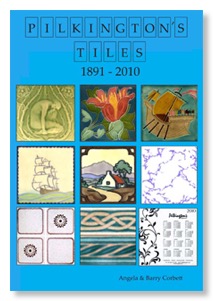E-News Winter 2013

Here’s What’s Below
More Batchelder Tile Discoveries
Pratt & Larson Celebrate!
Muresque Masquerade
Teamwork at Ravenswood
More Mystery Tiles
Murals Reflect “Sustainability”
Silver City’s Clay Festival
Kate Brown’s Wild Ride
Silver City’s Heritage Windows
New Books & Publications
E-News in Print
Comments about E-News? Share them for posting!

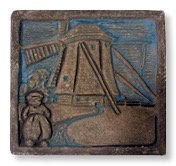
More Batchelder Tile Discoveries in the Northwest
Five Batchelder 6x6 “Dutch” tiles adorn a fireplace mantel at the Campbell House in Spokane, Washington.
Above Nos.78 and 81. From Patty Dean, Director of Preservation & Sustainability, at the Montana Preservation Alliance in Helena: the Campbell House in Spokane, designed by architect Kirtland Cutter in 1898, now the Northwest Museum of Arts & Culture. Of the nine fireplaces, the Batchelder tile mantel would have been added later as part of a remodel sometime during the 1910s or ’20s. As there are blue and white Dutch tiles surrounding the fireplace in the dining room of this English Tudor Revival mansion, which are presumably original to the house, it seems fitting that five of Batchelder’s Dutch designs were selected for this fireplace. The 6x6 inch tiles were among the earliest created by the modelers at Batchelder & Brown in Pasadena and may well have been developed as prototypes for the Dutch Chocolate Shop, Batchelder’s largest commission to date in 1914.

More Batchelder... in Portland
Shoppers from all over the world gravitate to the Portland Outdoor Store at 304 SW 3rd Avenue if not for the “western” look in clothing then for the sweet smell of fresh leather! Few, however, notice the historic tiles as they pass by when entering the 1914 building!
However, Tile Heritage member Georganne Ferrier stopped short; she knew she was looking at Batchelder tiles, these embedded in a field of California Art Tile, both from California.

And while in Portland...
Pratt & Larson Ceramics, an Industry Sponsor of the Tile Heritage Foundation, is celebrating 30 years in business! In honor of the 30th anniversary as a local business in Portland, Oregon, the Oregonian published a feature about the history of the company. Click here to read the article.
Michael Pratt and Reta Larson began production of art tile in 1982. In the successive years the company has grown to be a national leader in tile design. Employing over 80 people in all phases of design and production, the company creates and produces tile that is distributed across the United States and Canada. The handcrafted product reflects the art, interest and spirit of all involved in its production.

“I’m hoping you can identify the tiles installed on a fireplace in a house in East Oakland, California built in 1929. Is there a better way to clean them up? When we bought the house 3 years ago, there were at least 5 or 6 coats of paint covering the entire fireplace, and since I don’t know for sure who made the tiles, it’s difficult to know how vibrant or muted the original colors were. Any help you can give us would be much appreciated!” Kelcey Poe
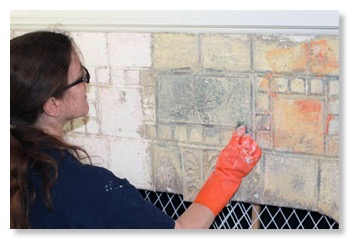
These are Muresque Tiles made in Oakland in the late ’20s, early ’30s. The company was founded by William Flynn Muir, a tile setter originally from Scotland who had settled in Fresno when he arrived in the States in the mid-1910s. With his wife and two daughters, he moved to Oakland in 1925 to make tiles rather than install them. Of course, the Depression hit in 1930 just as the company published its extensive catalog of decorative tiles (go to THF Catalogs for Sale and scroll down ) and stopped making tiles shortly thereafter. The company was sold and moved to Denver in the mid-’30s, closing some years later.
“We tried using a “green” paint remover first and got moderate results. A friend suggested we go with the big guns and get the toxic paint stripper. That worked well to get almost all of the many layers of paint off the tiles. I then used mineral spirits, then vinegar and water, then mild soap and water, then just water to scrub off the leftover haze.” Kelcey Poe
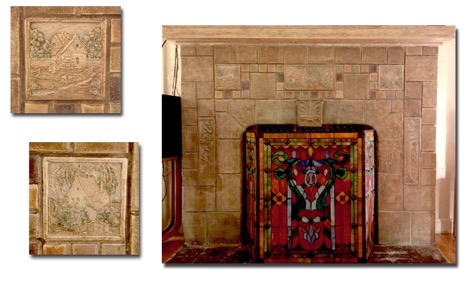
As pictured here the tiles are the right color. You can't "clean" them any further. This is the way they're supposed to look. If you want to enrich the surface, providing more "warmth" and depth, try a coating of Paste Finishing Wax by Minwax. Apply it first in an inconspicuous area to see if you like the effect. Then coat all the tiles, buff them with a dry cloth and live with them for a week or so. If then you want to try a slightly darker tone, apply a second coat.
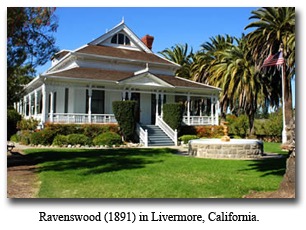
International Teamwork at Ravenswood
Riley Doty and Phylece Snyder of Oakland, California report the completion of their restoration of a geometric/encaustic tile floor at Ravenswood, a historic house in Livermore built in 1891. 70% of the original tiles had been removed unbroken and stored in the cellar for decades. The missing 30% was supplied by Steve Sinnott of Heritage Tiling & Restoration in the UK. Samples of each of the 13 various tiles of differing sizes/shapes/patterns were sent to Steve in Liverpool, and he rounded up the needed replacements, about 280 individual missing tiles. The final result, combining the originals and replacement pieces, looks virtually seamless!
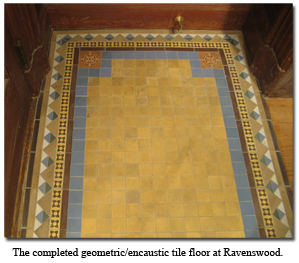
Of the thirteen needed types: a supply of one encaustic liner tile was reproduced as a custom job by the Craven Dunhill company; another was an off-the-shelf encaustic repro by the same company that was substituted for one whose design was a very close match (only three pieces of that pattern were needed); five were repros of geometric solid color tiles made in England for the Victorian restoration market; six were cut from tiles from Steve’s supply of old tiles that he’s salvaged from tear-outs over his 35 years of work restoring Victorian tile floors. Riley promises to put together a captioned web album of the entire process, so look for that in the future in the Special Features section of the THF website.
Ravenswood, located at 2647 Arroyo Road in Livermore, was built by Christopher A. Buckley Sr., known as the "Blind Boss" of San Francisco politics in the 1870s and 1880s. While it served as a summer home for the Buckley family from 1885 to 1920, Ravenswood was also one of the larger early vineyards in the Livermore Valley.
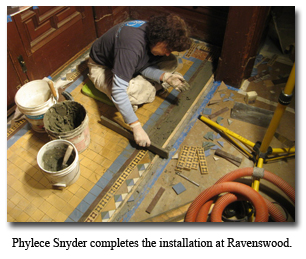
Ravenswood is on the National Register of Historic Places, a State of California Historical Point of Interest and a City of Livermore Historic Preservation Landmark Site. This project was made possible by the efforts of Maryalice Faltings, Director, Livermore Area Recreation and Park District and Fred Haldeman, Facilities Maintenance Supervisor for LARPD.
More Mystery Tiles

From a gentleman in Seattle: “I am trying to educate myself about historic tile and found your site. I recovered a few tiles from a building that was set to be demolished, and I am wondering if you would help me to identify the maker or provide any other information. They appear to be concrete or cement bodies, with a beautiful, multicolored nature scene. The surface is not flat but has slight variations with the design. These came out of the Seattle area. I would really appreciate any help you could provide.”
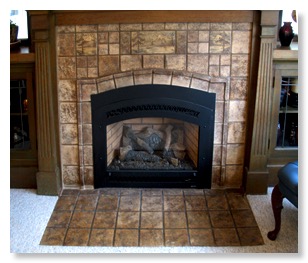
And from our friends at Art Tile Co. in Seattle: the fireplace mantel on the left with a detail below is an additional example of a cement tile installation. We believe that the tiles date from the 1930s, produced in the Seattle Area, but by whom? Can you help identify these tiles or provide any additional information? Email us: foundation@tileheritage.org.
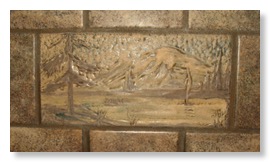
And another mystery: does this look familiar? Now privately owned, this fanciful mural was said to be from the St. Louis World’s Fair in 1904. It was purchased 20 years ago from a demolition company in St. Louis. Details (close-ups) of each figure are available for the asking. Let us know what you think!


Murals Reflect “Sustainability”
From Stephanie Osser
“I have wanted to share with you that I was the impresario of two successful bas-relief tile murals working with students, faculty and staff from Babson College and Wellesley College both in Wellesley, Massachusetts. Funded by a BOW Mellon Presidential Project grant, we succeeded in making two murals on the theme of “sustainability” to be installed at Babson and Wellesley, while I was working at the ceramic studio I managed at Babson for the past six years.”
Images of sustainability in the Babson mural (to the left) include Mandell Family Hall, which uses 40% less energy; light bulbs, as the college has undergone significant efficiency upgrades; Big Belly Solar, solar-powered compacting trashcans; and Bike Share, encouraging students to ride bikes around campus.
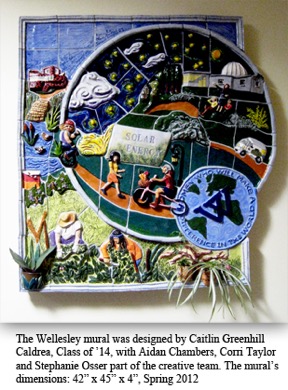
Sustainability also provides the dominant theme on the Wellesley mural as well (to the right). The recently renovated Whitin Observatory on campus was awarded LEED certification; the restoration of the Alumnae Valley including the Cattail Pond; LED lights in the college lanterns; beehives and bees brought on campus; a photovoltaic solar array; a zero-emission, all electric van; “pink” bikes; and students’ gardening/farming efforts.
“I feel like boasting about the two murals, as I am so proud of what we accomplished with non-art majors from a business school (Babson) and a liberal arts school (Wellesley).”
Silver City Clay Festival
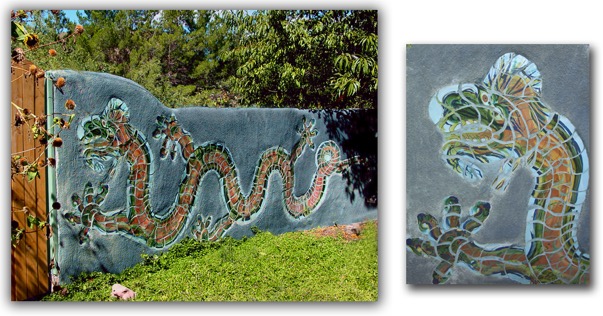
Kate Brown’s Wild Ride
“It began as a query for a dragon mural, a commission that ended up not happening, but by that time I was fully engaged to the point of creative obsession... and I had a new wall I had just built right out my front door. “I’m not sure when, but somewhere in the great wild ride of making the dragon, I came to see I was creating a portrait of the place I have lived for the past 32 years, on 320 acres in the Mimbres Valley where 1/2 million gallons of water at 140 degrees comes out of the ground every day. I am a member of the New Mexico non-profit corporation that owns the land, a communard in an intentional community. The head of the dragon is the hot springs and the back is the hills that surround the bowl where we live.”
Kate Brown established her studio in San Lorenzo, New Mexico in 1983, adding tile to her pottery production in 1994. She’s a master of slip-decorated, clear-glazed terra cotta ware. See http://www.katebrownpottery.com/
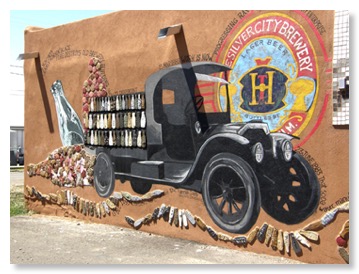
“Here’s to Ya!”
The Silver City Bottling mural honors the history of local bottling. Under the direction of artist Buck Burns with Diana Ingalls Leyba, the students from Stout Elementary created the ceramic pieces and glass mosaic; high school students and university students worked on the installation and painted parts of the overall design. The mural is located on the east wall at 416 Silver Heights Blvd (Rt. 180 & Corbin) and was completed in the spring of 2012
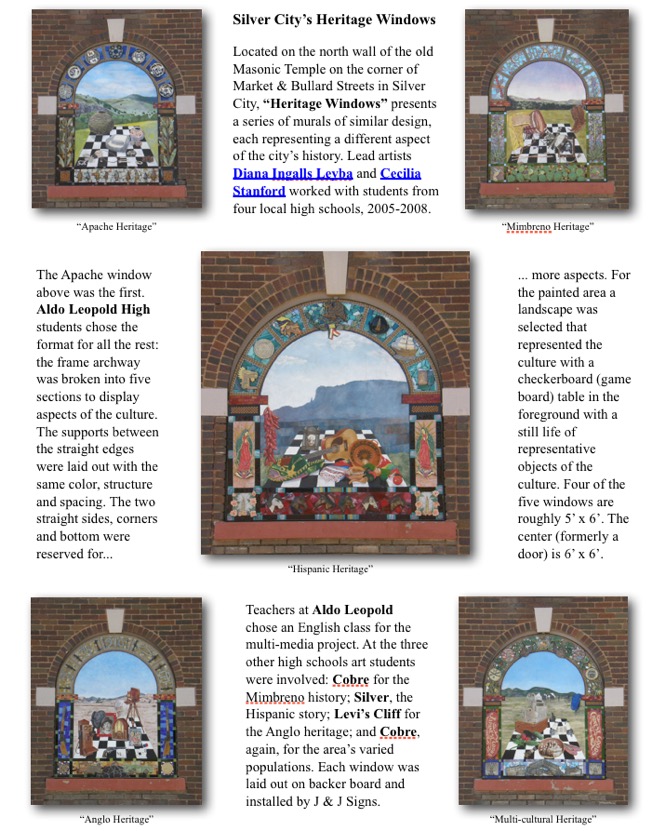
Diana Ingalls Leyba Cecilia Stanford
New Books & Publications
Art Deco Tiles, by the preeminent tile scholar Hans van Lemmen, charts the impact of this daring new style on the production of tiles and architectural faience in Britain. Art Deco was arguably the twentieth century’s most popular and memorable design movement. See http://www.shirebooks.co.uk/
The intent of the annual directory of the Handmade Tile Association is to allow easier access to the tile and mosaic artists and the resources around them to better serve the public, tile setters, designers, contractors, architects, and organizations of the community and beyond. Click here to order your FREE tile directory.
This book, soon to be published in 2013, is the first complete detailed history of an English tile company covering from late Victorian times to the modern day. The early Pilkington's history records some interesting contacts with American companies. For example, Pilkington's supplied Rookwood with pottery glazes. More importantly, much of the company’s modernization in the 1930s was after their MD Joseph Burton visited some twenty tile companies in the U.S. See http://www.pilkingtons-lancastrian.co.uk/index.html
TADA (Tile for Architects, Designers and Affiliates) is the newest trade magazine published by NTCA, the National Tile Contractors Association and edited by Lesley Goddin. Each issue is available in its entirety online. See www.ntca-tada.com
Celebrating the 100th anniversary of the magnificent Woolworth Building in New York City, this 18-page booklet is filled with dramatic archival photos and illustrations of architect Cass Gilbert’s masterpiece clad in 7,500 tons of Atlantic terra cotta. Price: $7 includes mailing. Send a check to Friends of Terra Cotta,
c/o Tunick, 771 West End Ave. 10E, New York, NY 10025.
E-News in Print
JOIN TILE HERITAGE!
Send Tile Heritage your ‘Tile Tales’ - Share pictures of interesting installations both historic and contemporary as well as restorations and other tile treasures! Submission guide lines
See who Sponsors Tile Heritage Foundation
Link to E-News prior to Spring 2010


